-
Content count
42 -
Joined
-
Last visited
-
Days Won
2
Posts posted by remod
-
-
Thanks, Silent Thunder. The last cards I posted on DA are the result of me "steering" an AI toward the images I had in mind, I liked the result even if I wasn't capable of directly drawing them myself. The others I made myself but they were much much easier :).
You can find those eight cards (actually a revised version of those cards) ready to be printed here: https://github.com/rdentato/castingiching/releases/download/v1.0.0/8-I-Ching-cards.zip
In the zip file there is also an "instructional card" showing how to use them. I've ordered a printed version on PrinterStudio just yesterday. It will take a month or so to arrive at my door, I'll post a photo when I'll get them so we can have a better idea of the printing quality.
I'll make the equivalent zip files for the other sets. I need some time since the Fu ones need the instructional cards, the set of 3 and 5 cards also need a proper design for their backside.
I'll see if can find some time this weekend to work on them and will let you know how to download them.
Thanks for your interest!
-
 1
1
-
 1
1
-
-
Hi Silent thunder, thanks for your comment!
I'm not planning to sell them but I'll make the hires files available for those who want to print them for themselves.
If can be helpful, I could set them for sale on a Print-on-Demand service (like MPC or GameCrafter) with 0% markup (i.e sold at the pure production costs) but I would need to check the quality first, I would hate to have them printed badly.
I should soon receive a deck of cards printed by Game Crafter, I'll post a picture of them when I'll get them.
I do have other cards already designed (I finally came up with a satisfactory solution for using three, four, or five cards) which I only posted on DeviantArt to avoid being too annoying on this forum
Just let me know which ones you are interested in and I'll set up the zip file with those cards in, I'll be very happy to hear your comments.
-
 2
2
-
-
I'm back to ask for your feedback and criticism.
This time I used two Fulu talismans that should (according to the creator) help to get the wisdom to sort out confusing situations (symbolized by the trigrams non being in their "natural" position) when one can only see things as black or white.
Please do not hesitate to come back to me with your comments. -
On 28/8/2021 at 7:15 AM, Harmen said:I had trouble finding information about this picture because the characters in the title were unfamiliar to me.
[...]
This kind of 'poetry in pictures' is not uncommon and they are often exquisite works of art.
Thanks for researching it, Harmen, I would have never been able to find it.
So, the trigrams were just there as ornaments, with no direct reference to the text.
Very interesting indeed.
Remo
-
 1
1
-
-
Following a link on Clarity, I found a book titled "Fang Family Ink Illustrations" (dated 1588) in which there is this picture (page 121):
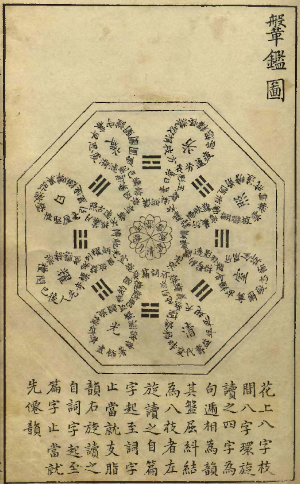
with the Houtian Bagua.
In my (very limited) experience I had never seen a Bagua intertwined with text arranged this way.
Do you know if there is any significance in this arrangement? Or is it just a one-off fancy from the author?
-
 1
1
-
-
I can't say I'm an expert but my understanding is always been that "Zhouyi" refers to the original text associated with a hexagram and every single line; no additional commentary, no interpretation.
"Yijing" is the general term to refer to that text plus commentaries and interpretations.
-
26 minutes ago, Taomeow said:It's the ancient representation of the I Ching generated by the initial (and eternal) transformation of wuji into taiji, with further division into "families" of trigrams, with further formation of hexagrams.
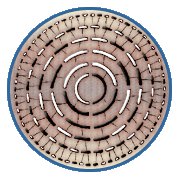
Incidentally, this is also what inspired me in creating the index at the center of the cards. The four circles work according to the same principle.
-
Since I'm at it, and just to show a completely different approach, the picture below shows a set of eight cards that can produce lines with yarrow stalk distribution. I focused on designing "abstract" cards as I don't like the commonly found 64 cards "I Ching decks" that try to replicate the tarots feeling, I feel they are too limiting in trying to squeeze an entire hexagram into a single picture.
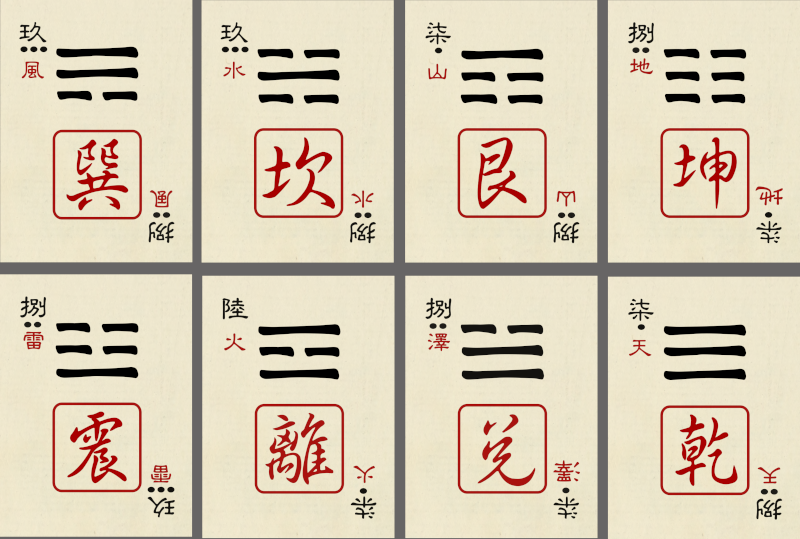
(the back is identical for all cards:
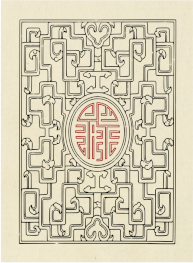 )
)
I use this more for their trigram part than to actually cast a hexagram. I still prefer to use a set of identical cards, it feels more "natural" to me.
Didn't want to sway the discussion, I still am more interested in having feedback on the card I showed in the first post.
-
 1
1
-
-
Thanks for your feedback, Taomeow!
Let me pick a couple of things from your post.
If I understand correctly, you too think that the asymmetry in the moving/non-moving line is significant. I always felt the same and this motivated me in avoiding methods that would generate lines with a different distribution. The card is designed to give lines with the same distribution as the yarrow stalks.
I choose to focus on cards exactly for the affinity paper as with wood; I felt that cards still retain that "being part of the natural world" that the yarrow stalks, as plants, have. That is also what made me discard computer-generated casting methods (even if I wrote one); I felt no connection at all with the casting process.
However, I can't deny that I might be biased by the long western tradition of using cards for divination.
Finally, you mention that you use a six coins method. Is the one with five equal coins and one different coin to represent moving lines? Or is it something different?
-
 1
1
-
-
Thanks for the comment, forestofemptiness.
It's a very good question indeed and when I started thinking about alternative ways for casting I Ching hexagrams, I ask myself the same thing.
I thought a lot about it and, in the end, I said to myself that what was important to me was:
- being able to follow the yarrow stalks probabilities for moving/non-moving lines,
- having a simple and portable casting method,
- retain the feeling of manipulating a set of objects to get a line,
- using something I felt a strong affinity with.
After having tried and devised lots of different methods (based on dice, cards, coins, ...) I found that using these cards has an additional benefit: they allow me to cast an entire hexagram without having to stop after each line to take the pen and draw it on a piece of paper. Which is something that often distracted me from the question I had in mind.
But I would really love to hear about how important and relevant the traditional methods are for you and why.
This post is exactly to get this type of feedback!
Thanks!
-
 1
1
-
Got it, it's sixteen sides dice. Nice!
Yes, those are the yarrow stalks probabilities, (the same produced by the cards above).
I'm always happy to see explorations on methods for casting I Ching hexagrams.
-
 1
1
-
-
Thanks for the comment, Sketch.
To get yarrow stalks probabilities I guess you are using two 12 sided dice, or are you throwing a single die twice?
Depending on this I can think of two ways to mark the faces to have yarrow stalks probabilities.I'm curious about your solution.
-
I printed seven of them (to be used as shown in the example).
You can use just two cards and draw the lines with pen and paper as usual.
Using just one card is possible but a little bit inconvenient (you should flip and turn the card, draw the line, and remember which red ideogram is on the top left corner. Then you flip and turn the card again and look at the black ideogram to check if it's the same, in which case it's a moving line. Rather cumbersome ...)
Also, you can use six cards (or seven to have the index available) in conjunction with any other method (e.g. three coins). Just cast the line as usual and stack the card to build up the hexagram.
Do you think it's a useful feature to be able to keep track of the forming hexagram without having pen and paper at hand?
P.S. I didn't explain how the four circle index works but is not really needed for casting.
-
 2
2
-
-
Hi, silent thunder. Thanks for replying!
The easiest way to understand it is to consider two of those cards.
You shuffle, flip and turn the two cards and then make a sort of "L". The front card tells you which line you got (the bigger lines at the top or the bottom of the card), If the two ideograms (one black, the other red) in the top left corner are the same. It's a moving line.
I've prepared a picture with an example (see below).
Let me go line by line:1. Broken line, same ideograms -> moving line (as if you got 6 with the coins)
2. Solid line, different ideograms -> non-moving line (as if you got 7 with the coins)
3. Broken line, different ideograms -> non-moving line (as if you got 8 with the coins)
4. Broken line, different ideograms -> non-moving line (as if you got 8 with the coins)
5. Solid line, same ideograms -> moving line (as if you got 9 with the coins)
6. Broken line, different ideograms -> non-moving line (as if you got 8 with the coins)
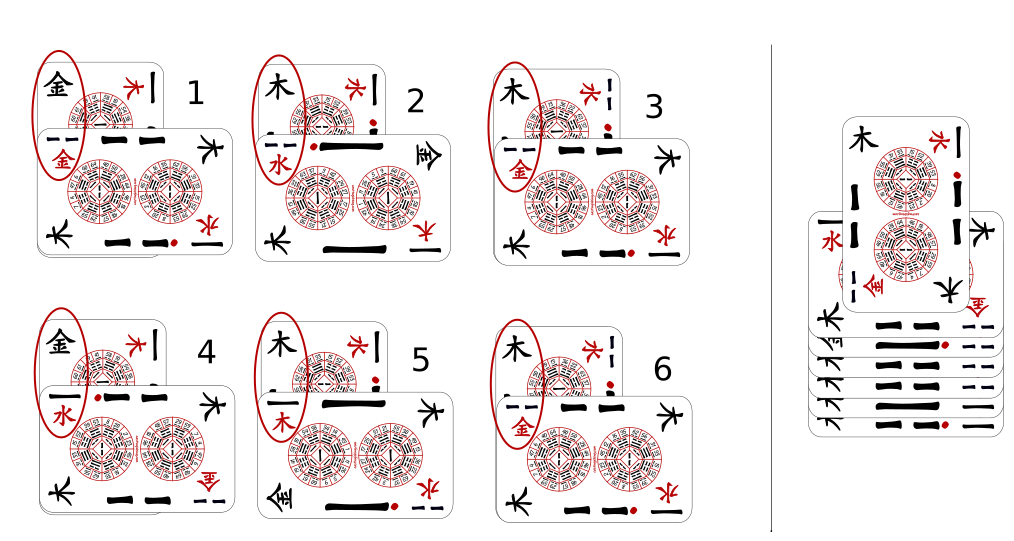
On the right of the picture is shown what happens if you use seven of those cards and stack them while casting: they will form both the primary and the secondary hexagram (moving lines are marked with a red dot).
The result is the hexagram 48.1.5 > 19.
Hope it's a little bit clearer. Please, do not hesitate to ask!
-
 1
1
-
-
Hello,
I'm looking for feedback on a card I designed for casting I Ching hexagram.
You can use one or, better, two or, even better, seven of them (if you want to take advantage of their "tracking" capability) to cast an heaxgram line by line.
It is equivalent (from a probabilities point of view) to using the yarrow stalks method.
I also added an "index" to retrieve the hexagram number from the line (the four circles) which is not really intuitive but, once clarified, shouldn't be too much difficult to use. (of course, one can use any other index to go from the hexagram lines to its number).
I did not get much comments on my (scarcely visited) web site, so I'm posting around trying to find someone interested enough to provide some feedback (wether positive or negative!). I'm using seven of them and found it very useful not to have to pick pen and paper between each line to mark the casted line.
Any question or comment is really welcome!
The image below shows the front and the back of the card:
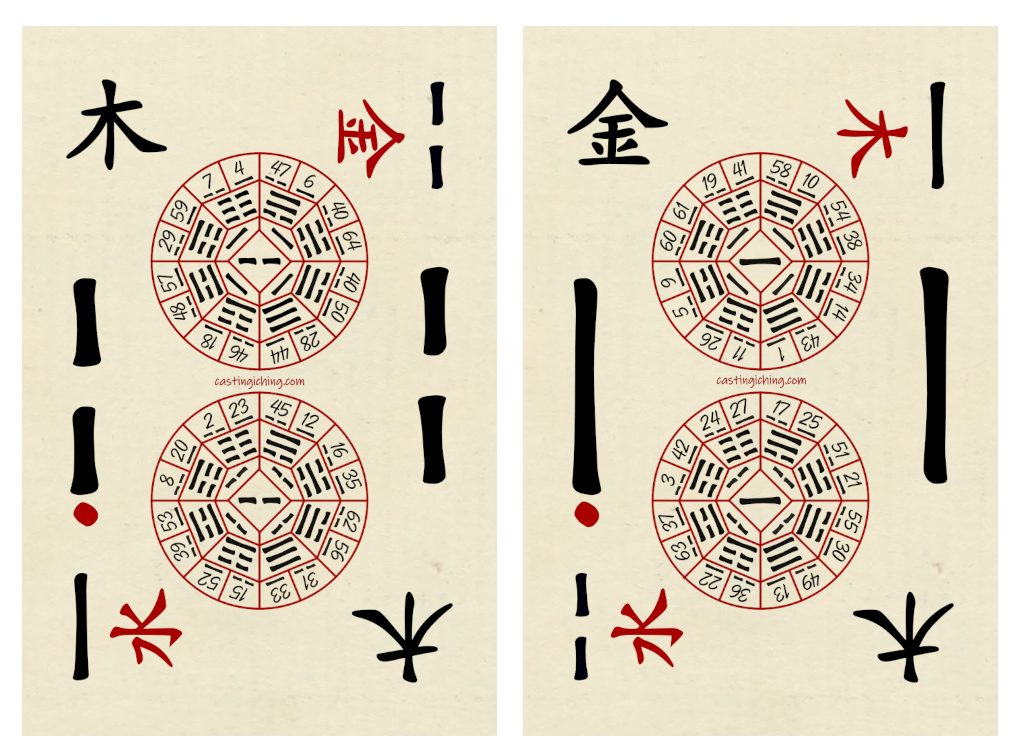
-
 3
3
-
 3
3
-
-
Hello. I've been fascinated with the Asian Culture since a I was a little kid.
The writing system, martial arts, music, imagery, ... everything was misterious and intriguiing.
It was many, many years ago; information about those topics were scarce and books in my native language (Italian) were extremely rare.
Above everything, one thing has remained constant in my life for all this time: I Ching. I discovered them when I was 14 and since then I had a mentor and counseler that would help me looking through the situation (and myself) more clearly.
That's my main reason to be hear. I hope to learn more and, possibily, share the little I know.
Remo


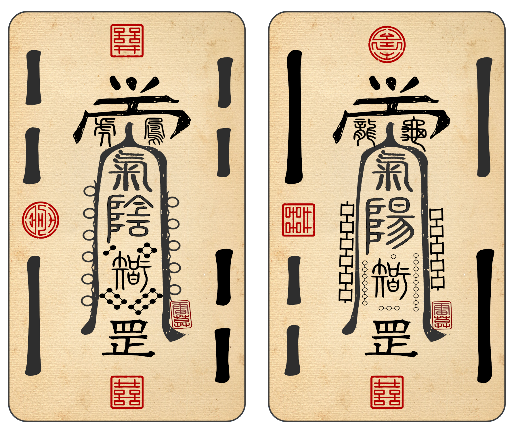
Asking for feedback
in Yijing
Posted · Edited by remod
Happy you liked them
In the meantime, I managed to make the instructional card for the 7 cards with the FU talisman.
You can find the hires images here: https://github.com/rdentato/castingiching/releases/download/v1.0.0/7-I-Ching-Cards-FU.zip
Since you mentioned you plan to use Game Crafter, I named the files so that it will be easier to set up the deck on that platform (but you can use any other you like).
I'm curious about your paintings, did you publish them somewhere? (DA, Instagram, Pixiv, ...). I'd love to see them!